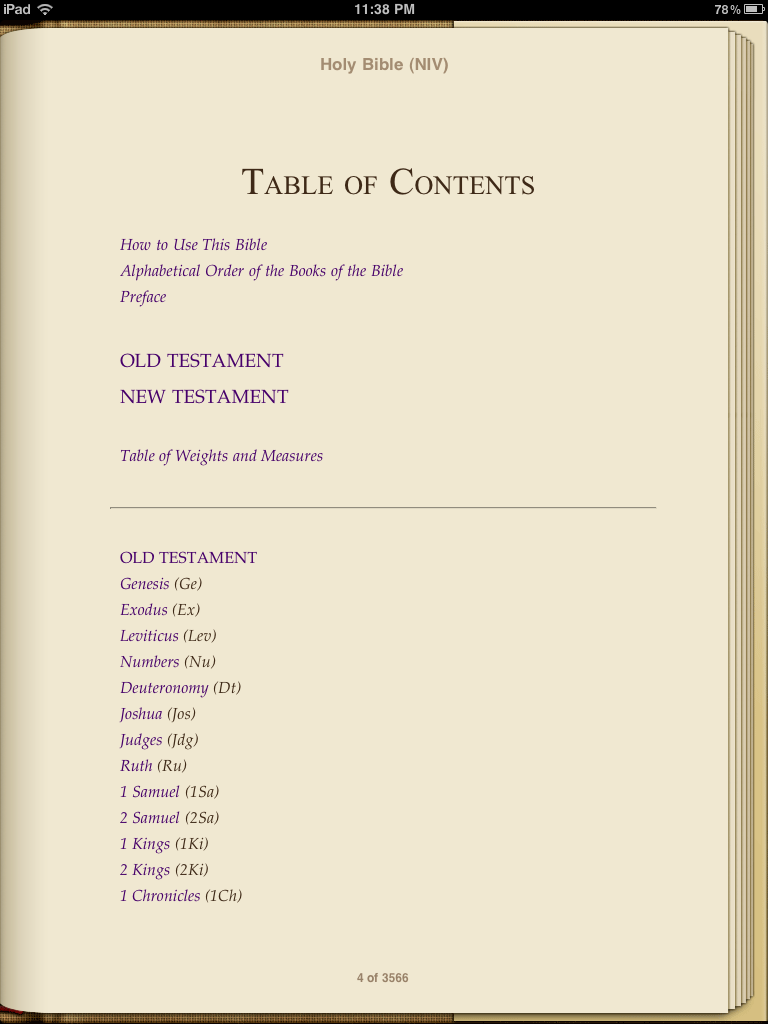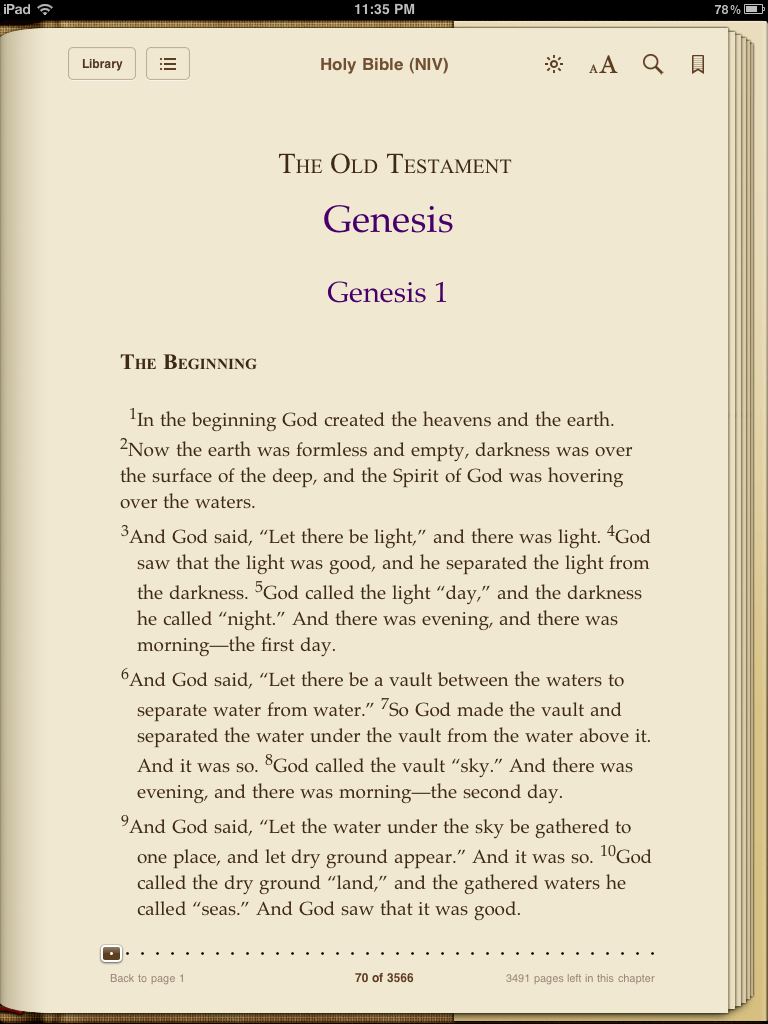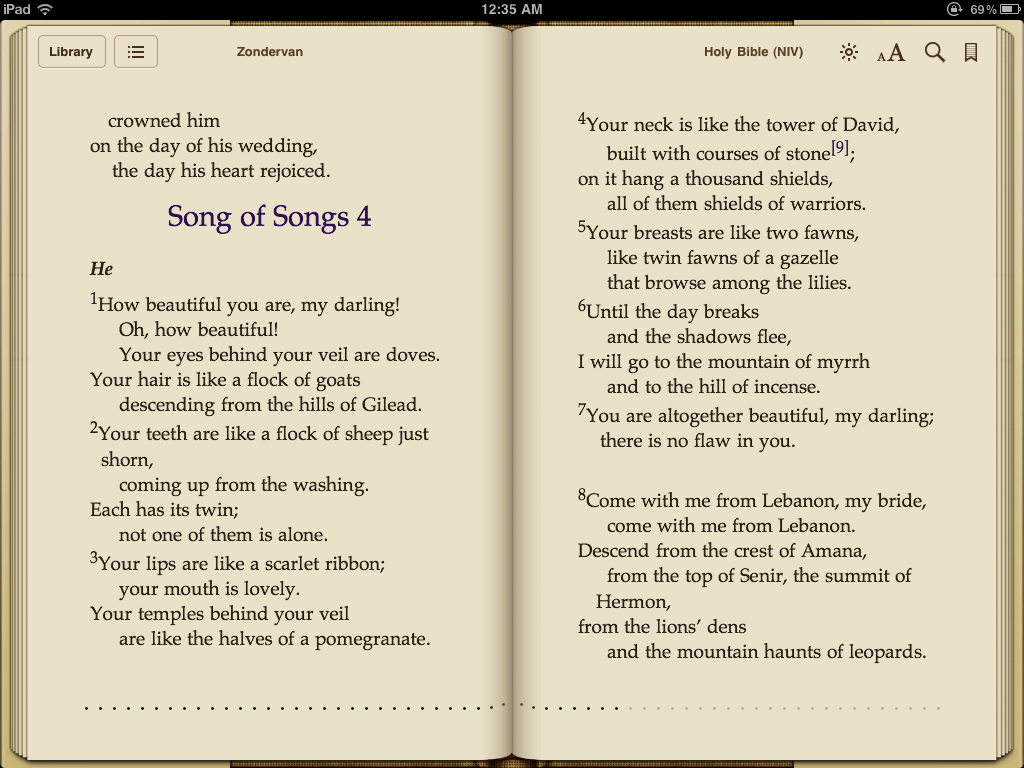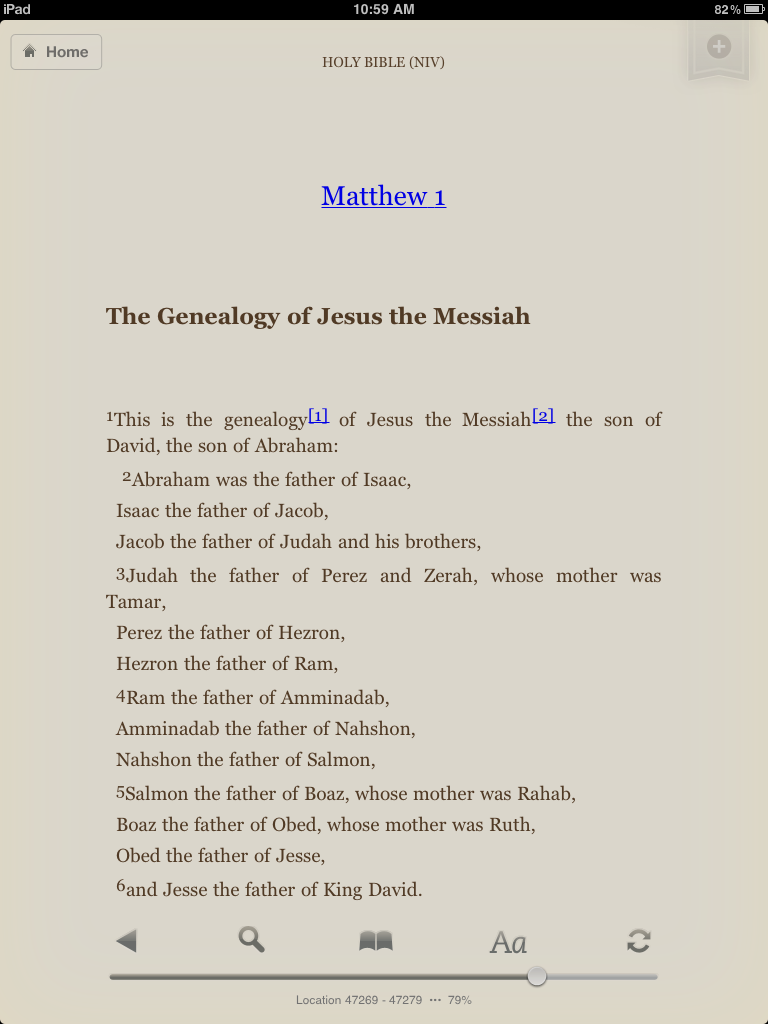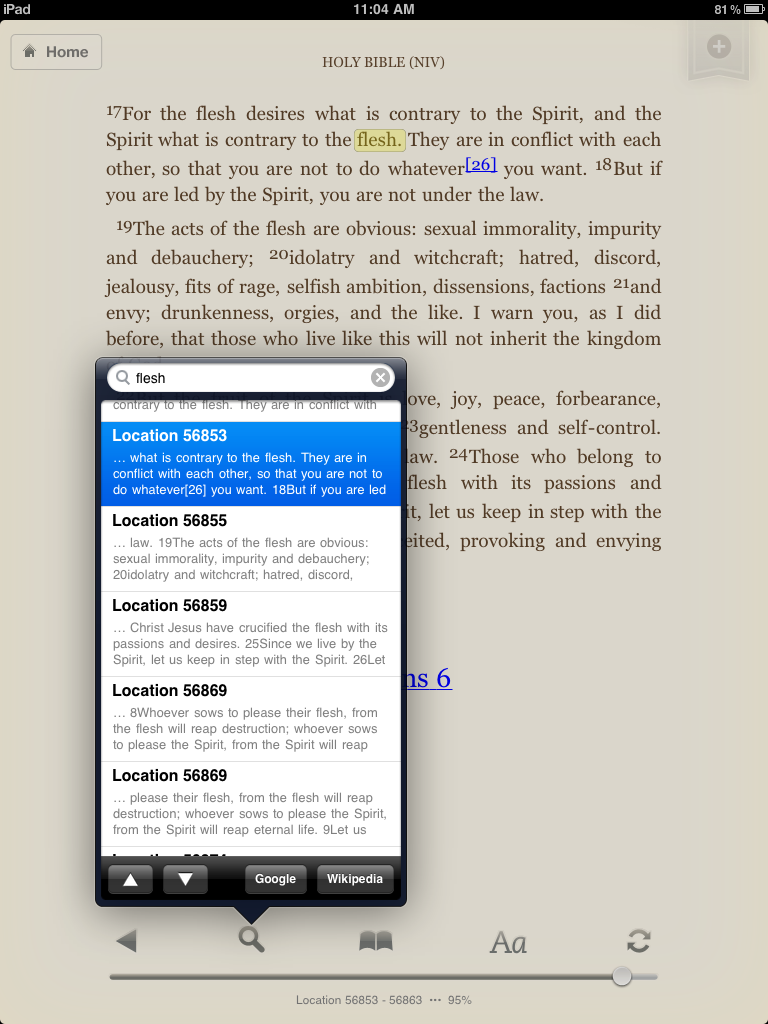As promised, the Committee on Bible Translation (CBT) released the "2011 edition" of the New International Version, Monday, on BibleGateway.com. Print copies are expected to follow by March, 2011.
This post is not a full review, but just as the title says, merely some initial thoughts. I doubt I would even attempt a full review until the text is "finalized" in print form or at least until I have a copy in Accordance where I can make better comparisons with both the 1984 NIV and the 2005 TNIV.
Almost immediately on Monday morning, I had emails asking me what I thought about the new NIV update and if I was going to post something here on This Lamp. My time has been so short lately (as evidenced by only one short post last month) that it's taken me three days simply to write this. I haven't had time to read a number of your thoughts and reviews on other sites, and I apologize for that. I realize none of us live in a vacuum. But perhaps, this allows me to simply write, without outside influence, the post that I would have uploaded Monday morning had I had more time.
I highly recommend that readers take a look at "Translators' Notes" released by the CBT for details regarding the decisions made in the new edition of the NIV as well as examples of distinctions from the original NIV and the TNIV. I will interact with some of this content below.
Here are a few observations I immediately noted:
- The 1984 NIV and the TNIV have both been pulled from BibleGateway. The only translation now available is the updated NIV. I will be very interested to see if publishers of the NIV will be disciplined enough to follow suit and discontinue any new printings of the 1984 NIV once print editions of the update are released in 2011. Update: the 1984 NIV and the TNIV are now back on Bible Gateway.
- Speaking of which, except when needed for comparison, the new revision is simply being called NIV. Elsewhere in the Translators' Notes, the CBT refers to new edition as "the updated NIV" only when comparing the revision to the original edition. "Updated NIV" appears 21 times in the Translator Notes.
- The copyright on BibleGateway is dated 2010, but the Translators Notes still refer "Updating the NIV for 2011" and "the English of 2011" (p. 2).
- When the CBT first announced its intentions regarding the NIV (and the retirement of the TNIV) in 2009, statements were initially made that the 2011 edition of the NIV would be the first revision to the NIV, completely ignoring the 1996 "Inclusive" NIV and the 2005 TNIV (The TNIV preface begins with "Today's New International Version [TNIV] is a revision of the New International Version [NIV]"). Those statements were later toned down, and in some cases disappeared from some of the statements that were in print. The Translators' Notes do refer to the TNIV in many places, but it is said that the TNIV was "separately published" (p. 2). I'm not certain exactly what this means other than the fact that there seems to be an effort on at least a subtle level to distance the updated NIV from the TNIV. There is no mention of the NIV revision released only in the UK in 1996.
The greatest challenge a new or revised Bible translation faces is acceptance. There's no real point to having a translation of the Bible if it's not going to be used. There's always a fine line between distinguishing a new translation or revision from the past while not going so far out on a limb that potential adopters are turned off. People have their pet verses, and if a new translation doesn't word these verses exactly to their liking, often the new version of the Bible is not given much consideration afterwards. And, of course, one of the most common verses affected by this not-always-fair-evaluation method is John 3:16. Most people who have not studied New Testament Greek look at John 3:16 not on the basis of how well it conforms to the Greek, but in regard to whether or not it veers too far from the traditional wording they knew, usually from the King James Version.
I look at John 3:16 in a new version, too, but not for the same reason. I always hope that it corrects traditional wording and communicates to a modern audience what the words that the gospel writer originally intended. When William Tyndale translated οὕτως γὰρ ἠγάπησεν ὁ θεὸς τὸν κόσμον as "For God so loveth the world..." (adapted by the KJV translators as "For God so loved the world...), his rendering was perfectly acceptable for his time. But for today's audience, the meaning is wholly misunderstood.
People tend to read this verse as "God SOOOOOO loved the world..." but that's not what it means. The word οὕτως, which is translated as the so in John 3:16 does not mean the understanding I described in the previous sentence. It means "referring to what precedes, in this manner, thus, so" (BDAG). Therefore, it's not that the traditional rendering is incorrect. Tyndale intended his use of so to be understood in this regard, but today it's almost always misread.
Every time a new revision of the NIV is released (and remember the 2011 edition is not the first revision; there have been two before it), I always hope that John 3:16 will be corrected from its potential to be misread. However, it remains untouched in this new version. Incidentally, the HCSB and NET Bible get it right, while the NLT actually reinforces the misreading!
Retaining the traditional reading: updated NIV
|
| For God so loved the world that he gave his one and only Son, that whoever believes in him shall not perish but have eternal life. |
Getting it right: HCSB & NET Bible
|
| For God loved the world in this way: He gave His One and Only Son, so that everyone who believes in Him will not perish but have eternal life. (HCSB) |
For this is the way God loved the world: He gave his one and only Son, so that everyone who believes in him will not perish but have eternal life. (NET) |
Making it more confusing: NLT
|
| For God loved the world so much that he gave his one and only Son, so that everyone who believes in him will not perish but have eternal life. |
As I already suggested, the Translators' Notes are worth reading on your own. I'm not going to rehash issues like translating κατάλυμα as "guest house" instead of "inn" in Luke 2:7 since this was first introduced in the TNIV and I wrote about it four years ago. There are a number of significant issues that could be discussed, but I believe the real question that everyone was interested in on Monday related to how the updated NIV handles the gender issues for which some criticized the TNIV.
Most of these issues never had anything to do with complementarian vs. egalitarian debates, let alone"feminist" issues. Rather, these translation choices have to do with how well the biblical writer's intent is translated into English. These are simply communication issues. I want the biblical message to be clearly heard by all in the manner the original writers would have wanted it to be heard. To me this should not be political or even theological, but should come from a desire to clearly communicate God's revelation in a different language to a different culture.
Retaining the Singular They
Honestly, I'm surprised. I felt that one of the compromises the CBT would make would be to remove the use of the so-called singular they—that is, when a third person plural pronoun is used as a singular to incorporate both male and female genders. With all the nonsense that went on in the criticisms of the TNIV, I felt the singular they was the only true controversial translation choice—and that wasn't because I actually find the singular they to be controversial, but only because it had never been used in a major Bible translation.
The CBT has stated:
Singular ‟they,” ‟them” and ‟their” forms were widely used to communicate the generic significance of pronouns and their equivalents when a singular form had already been used for the antecedent (p. 6).
I accept the need of the singular they, even though I still mark it in the freshman writing classes that I sometimes teach (my goal is to have students think about the connections between their words at early levels of writing, but I always discuss this issue in detail with them).
And while singular theys can be a good solution for an inadequacy in the English language, they can still be tricky in their own right. Consider the NIV's history for Revelation 3:20—
NIV 1984
|
TNIV 2005 |
NIV 2011 |
| Here I am! I stand at the door and knock. If anyone hears my voice and opens the door, I will come in and eat with him, and he with me. |
Here I am! I stand at the door and knock. If anyone hears my voice and opens the door, I will come in and eat with them, and they with me. |
Here I am! I stand at the door and knock. If anyone hears my voice and opens the door, I will come in and eat with that person, and they with me. |
Note that the very real awkwardness of the close proximity of them and they in the TNIV. The updated NIV is an improvement, but I can't help still "hearing" it, and that might just be me. I accept the idea of a singular they, but it still can be awkward at times, and I usually can't help noticing it.
The type of improvement found in Rev 3:20 is found in numerous places. For instance, the everyone of Romans 2:6 (he in the 1984 NIV) is now each person in the updated NIV, giving emphasis upon the consequences of sin for each individual. Everyone is also singular, but each one seems to emphasize that a bit better.
In some cases, the CBT chose to move from a singular they back to a generic he. The reasoning for this is not explicitly stated by the CBT in the Translators Notes. The notes refer to Job 31:29 in which my ememys' [plural possessive]...them in the TNIV reverts back to the singular my ememy's [singular possessive]...him in the updated NIV. Here I can speculate that the change was made since שַׂנְאִי is singular and more than likely any enemies of Job would have been male (but would a female enemy be out of the question?). However, why the switch back to a generic he in Rom 14:22?
NIV 1984
|
TNIV 2005 |
NIV 2011 |
| Blessed is the man who does not condemn himself by what he approves. |
Blessed are those who do not condemn themselves by what they approve. |
Blessed is the one who does not condemn himself by what he approves._________ |
ἀδελφοί retained as brothers and sisters
In most cases, ἀδελφοί has been retained with the correct rendering brothers and sisters when the writer had both genders in view. This understanding of ἀδελφοί is fairly well established and something that even the ESV acknowledges in many footnotes to the text (making one wonder why the ESV translators don't simply put the more accurate phrase in the text).
There are a few interesting changes I stumbled across, though. In 1 John 4:21 one another of the TNIV has now been changed to the more accurate brother and sister, better reflecting the singular accusative ἀδελφὸν. And the (needlessly) controversial wording of Hebrews 2:17 takes a departure from all of its predecessors, creating a solution that perhaps will not be the target of so much misunderstanding:
NIV 1984
|
TNIV 2005 |
NIV 2011 |
| For this reason he had to be made like his brothers in every way... |
For this reason he had to be made like his brothers and sisters in every way |
For this reason he had to be made like them, fully human in every way |
_________
A few steps back?
I actually consider myself to be fairly conservative, but as I've described before, what really changed my mind about gender renderings in Bible translations was the day years ago when teaching Genesis 1 to a group of teenagers, a young woman raised her hand and stated, "Mr. Mansfield, I never knew women were made in God's image, too." I looked at her in disbelief; I assumed she was kidding. But she said, paraphrasing the first part of Genesis, 1:27, "All I've ever heard was 'Man was made in God's image'—not women." After realizing she was serious, I polled the rest of the class, only to discover that at least a third of them thought the same thing—both male and female students—but mostly female.
This is why I say this is not a political or a theological issue; it's a communication issue. The masculine universal Man will always have the potential to cause some misunderstanding; a more inclusive word—which does no damage to the faithful rendering of the original languages—will not ever cause the kind of misunderstanding that I described in the paragraph above.
And while I admit that mankind will cause less confusion than man as a universal, I still believe the usage of the former is a step backwards.
NIV 1984
|
TNIV 2005 |
NIV 2011 |
|
So God created man in his own image,
in the image of God he created him;
male and female he created them.
|
So God created human beings in his own image,
in the image of God he created them;
male and female he created them. |
So God created mankind in his own image,
in the image of God he created them;
male and female he created them. |
Consider how other contemporary translations have chosen to avoid the masculine universal and translate אָדָם— humans (CEV, GWT ) human beings (REB, TNIV, Message, NLTse, TEV), humankind (NRSV, NET, NETS), people (NLT1).
Again, I still don't like it, but admittedly mankind is better than the NIV's man. Nevertheless, the updated NIV employs man as a universal, too.
NIV 1984
|
TNIV 2005 |
NIV 2011 |
| Jesus answered, "It is written: 'Man does not live on bread alone, but on every word that comes from the mouth of God.'" |
Jesus answered, "It is written: 'People do not live on bread alone, but on every word that comes from the mouth of God.'" |
Jesus answered, "It is written: 'Man shall not live on bread alone, but on every word that comes from the mouth of God.'" |
For some NIV users, this will not be any big deal. But for those who used (and still use) the TNIV because of the way that verses like Gen 1:27 and Matt 4:4 are handled, I doubt the updated NIV will be seen as a fitting replacement.
σάρξ/Flesh/Sinful Nature
Much of what has been changed in the updated NIV comes as no surprise. This change, however, was unexpected:
Most occurrences of ‟sinful nature” have become ‟flesh.” Especially in Paul, sarx can mean either part or all of the human body or the human being under the power of sin. In an effort to capture this latter sense of the word, the original NIV often rendered sarx as ‟sinful nature.” But this expres- sion can mislead readers into thinking the human person is made up of various compartments, one of which is sarx, whereas the biblical writers’ point is that humans can choose to yield themselves to a variety of influences or powers, one of which is the sin-producing sarx. The updated NIV uses ‟flesh” as the translation in many places where it is important for readers to decide for themselves from the context whether one or both of these uses of sarx is present (p. 7).
Look, I realize that the NIV's rendering of σάρξ as sinful nature had been problematic in some circles. However, the English flesh is equally problematic because outside of church, English speakers today do not use the word flesh in the way Paul used the word σάρξ two millennia ago. Flesh is insider language, not necessarily representative of the spirit of the Κοινή Greek in which the New Testament was written. But I have no doubt that this, like the move to use man and mankind, were concessions by the CBT to appeal to certain elements in Evangelical Christianity.
Restoring Messianic Allusions
I know some of you will think I'm contradictory here, but I do appreciate one of the particular "steps back" that the CBT made regarding the updated NIV. Again, the issues I've raised above, are nothing more than communicative issues to me. This one that I'm about to briefly mention really is theological.
In my initial review of the TNIV six years ago, I suggested that when it came to Old Testament prophecies and allusions to Christ, the theological importance of the passage should trump the desire to make a passage gender inclusive. I used Psalm 34:20 and John 19:36 as my example. Many of you disagreed with me strongly on this issue. And I understood the argument against me before I even made it:
The use of inclusive language blurs the prophetic nature of the passage. In my opinion, the choice to alter a verse like this is a distraction and brings unnecessary criticism to the TNIV. I've heard the opposing viewpoint--that an Old Testament passage needs to be treated in its own context, and I respect that. But I also read the OT as a Christian, and it's exactly these kinds of verses that root Christ throughout the Scriptures. I'm also aware that many quotations are slightly different anyway because most often the NT writers tend to quote the Septuagint instead of the Hebrew Scriptures; but again, I would leave such passages alone if I were running the committee.
Well, I haven't taken the time to run a thorough examination, but I can at least note that Psalm 34:20 in the updated NIV has restored "their bones" to the original "his bones. I believe that's a change for the better, but I know some of you will disagree with me, and that's fine.
How about my predictions?
When the NIV 2011 was first announced last year, I made a set of predictions. Let's see how I did.
(1) Get your TNIVs while you can as they will become more difficult than ever to find.
Well, that was pretty much a freebie. I have no insider knowledge about Zondervan's print runs, but it wouldn't surprise me to learn that no new TNIV edition was printed after the 2009 announcement was made. And TNIVs aren't totally impossible to find yet. I've seen some of them in the Sale bin at the local Christian bookstore.
(2) The 2011 NIV will be more gender inclusive than the ESV, but less so than the TNIV.
Nailed that one.
(3) Say goodbye to the Singular They.
Definitely wrong on this one. Honestly, I'm still a bit surprised.
(4) Regardless of how much the progress of the TNIV is compromised in the 2011 NIV, it will still be controversial.
Only time will tell on this one, but what I said in 2009 bears repeating:
The CBT is simply not going to satisfy some of the detractors out there. That crowd actually dislikes the NIV, too. The TNIV was simply their excuse to rail and promote "other" translations. Most of these folks will do the same thing to the 2011 NIV. However, if Zondervan can get Lifeway and other CBA stores to carry the 2011 NIV where the TNIV was forbidden, they will have at least made some progress.
(5) As we wait for the 2011 NIV, expect the 1984 NIV to keep on selling.
Again, I've got no insider information (after the TNIV was killed, Zondervan quit contacting me altogether—really). However, I wouldn't doubt that the NIV still sells quite well. And the updated NIV should continue to sell as well, too, thanks to its keeping of the same name.
Final thoughts (for now)
The updated NIV is many things. It's a correction to the NIV; it's in some ways a step backwards from the progress of the TNIV (with a few exceptions); it's by nature a compromise; it's a course correction. And it also represents the hope of Biblica/IBS and Zondervan (not to mention Hodder & Stoughton) for the continued opportunity to sell millions of Bibles.
I honestly don't know if the updated NIV will appeal to all the people who treasured the TNIV. And I'm not intending to sound ugly with this, but I'm not certain that any of its handlers care. TNIV users were a clear minority, although I primarily blame its handlers for their lack of promotion (and their inability to wean themselves from the NIV cash cow) for that fact.
Even I have moved on. I went back to using the HCSB, especially in its recent update. In reality, the HCSB is even more conservative than the updated NIV, but as I always say, I reserve the right to "correct" it on the fly as I read it in front of an audience.
If I can make another prediction, I'm certain the updated NIV will be just fine. The average consumer and church member in the pew doesn't even keep up with this stuff. They'll (that's a singular they) walk into a store and simply buy the NIV they (that's another one) see on the shelf. That's what the NIV's handlers are hoping for. It's now incumbent on them to stick to their guns and quit printing the 1984 NIV. If they don't, the NIV will eventually fade, although not probably in our lifetime.
I'm still undecided, but I'll try to keep an open mind. I've only been able to make a cursory look. I'll have to read it in its entirety. In the past, I would have said that I need to get a print copy to do a proper evaluation. These days, I'm content if I can simply get a copy on my iPad.
Hardcore TNIV users may not be satisfied. They may end up using the NRSV or the NLT or something else altogether. I doubt many will follow my lead in making the HCSB their primary translation (my secondary text is the NLT). But that's the beauty of translation choice.
And for what it's worth, there's also nothing wrong with sticking with the TNIV or even the original NIV if either of those are the translations from which you best hear God's voice.
One more thing: be certain to check out the detailed computer generated analysis that Robert Slowly has created, comparing the updated NIV to the original NIV and the TNIV— "NIV2011 comparison with NIV1984 and TNIV."
 Tuesday, May 3, 2011 at 11:39AM
Tuesday, May 3, 2011 at 11:39AM 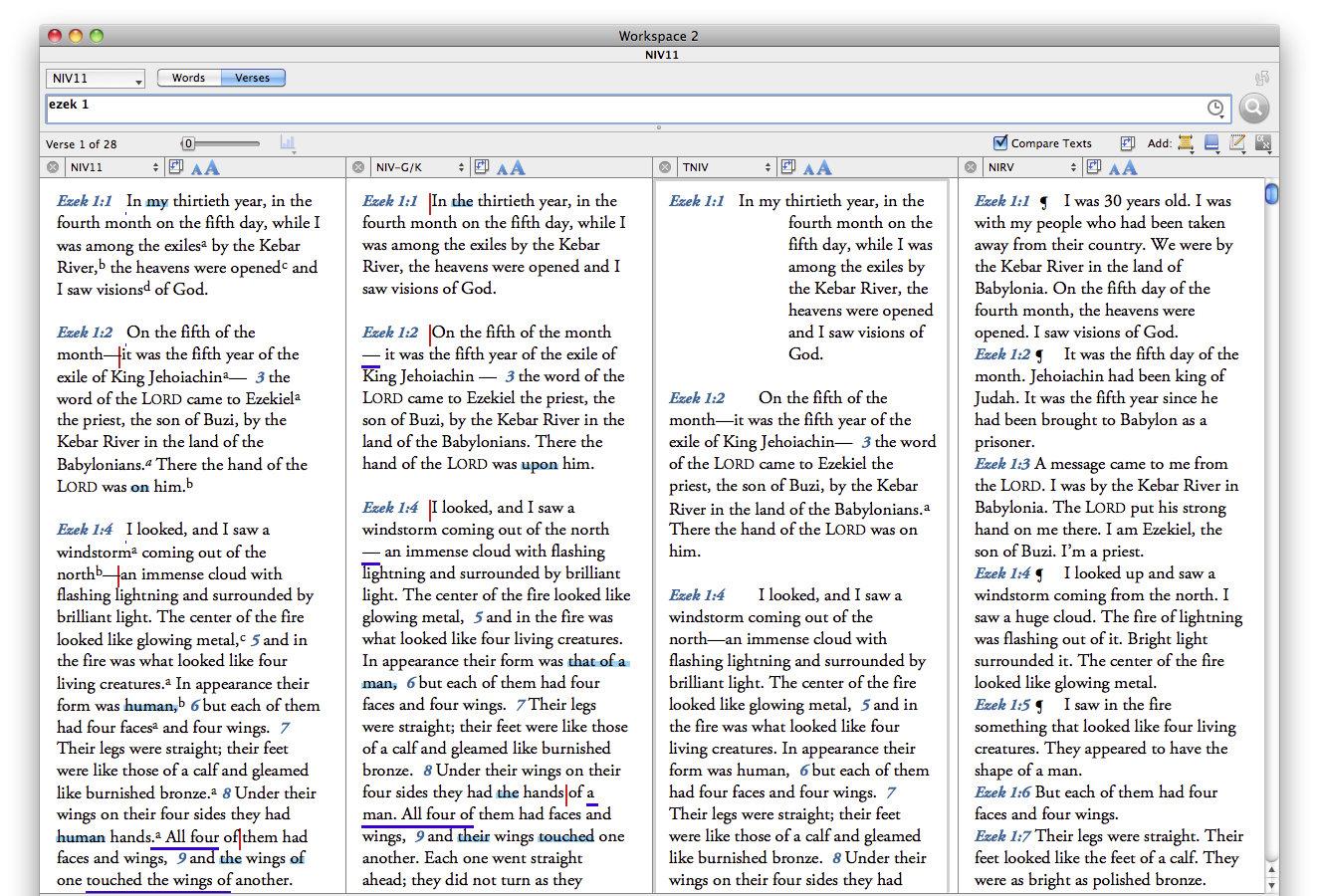 The whole family: NIV 2011, NIV 1984, TNIV, and NIRV
The whole family: NIV 2011, NIV 1984, TNIV, and NIRV NIV 2011 in
NIV 2011 in  Faith & Reason,
Faith & Reason,  Technology
Technology 



